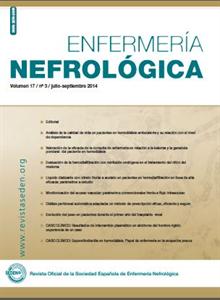Contenido del artículo principal
Resumen
La espondilodiscitis (ED) u osteomielitis vertebral (OM), indica un proceso inflamatorio, generalmente infeccioso, del espacio intervertebral y los cuerpos vertebrales adyacentes1. Representa entre un 2 y 7% de los casos de infección ósea, con una mayor incidencia en adultos entre los 60 y 70 años2,3,4. La infección estafilocócica es muy frecuente en los pacientes en hemodiálisis, siendo la bacteriemia por Staphilococcus aureus una entidad con una morbilidad significativa. El origen más frecuente de dicha bacteriemia son los accesos vasculares permanentes y los catéteres venosos centrales (se calcula que se producen de 1,5 a 5,5 episodios por cada 1000 días/catéter), de los cuales un 1,3 % desarrollarán en algún momento este tipo de infección, si bien la frecuencia es tres veces mayor con el uso de un catéter central que con una fístula arteriovenosa (FAVI)5,6,7. El diagnóstico en multitud de ocasiones es difícil debido a lo inespecífico de sus síntomas y la frecuencia con que se observa dolor de espalda en la población general8. En este artículo presentamos el caso de un paciente con bacteriemia por S. aureus que sufrió un absceso vertebral secundario y cuyo síntoma principal fue el dolor de espalda, refiriendo este síntoma a enfermería como primera instancia. Nuestro objetivo es que enfermería conozca este proceso con el fin de poder identificar los síntomas de un modo precoz.
Palabras clave
Detalles del artículo
Aviso de derechos de autor/a
© Los autores ceden de forma no exclusiva los derechos de explotación de los trabajos publicados y consiente en que su uso y distribución se realice con la Licencia Creative Commons Atribución - No comercial 4.0 Internacional (CC BY-NC 4.0). Puede consultar desde aquí la versión informativa y el texto legal de la licencia. Esta circunstancia ha de hacerse constar expresamente de esta forma cuando sea necesario.




